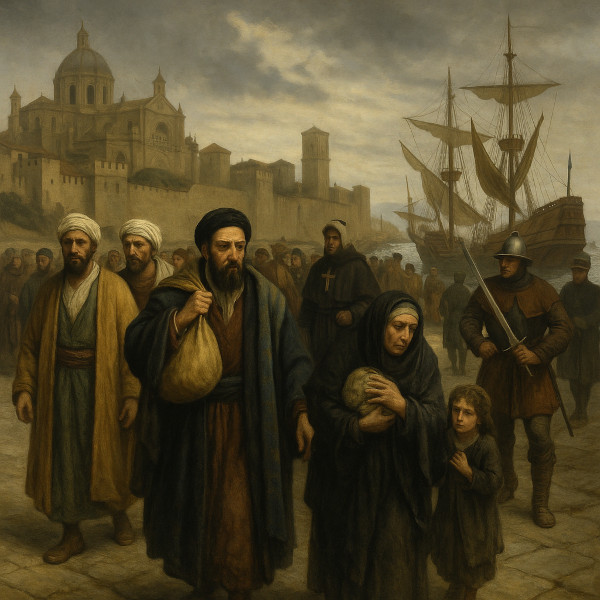
Ethnic Cleansing in Spain since 1492

At the time of writing which is October 2025 the anglo saxon world is going through a period where there is a growing popularity of intolerance. The problems of the country are blamed on immigrants and people of non Christian religions. In the USA right now many immigrants are being expelled from the country. In the UK there is rising popularity of the far right party of Nigel Farage who wishes to expel people who are not deemed to be British.
Spain has a long tradition of multiculturalism and also of intolerance. There were epochs when Jews, Christians and Muslims lived in harmony together and times but also times of terrible cruelty and persecution. We can sometimes forget that what is happening in the present has happened many times in history and we can see effects of what will happen by looking at the past.
This is a short history of Ethnic Cleansing in Spain since 1492.
 Major Expulsions and Forced Removals in Spain After 1492
Major Expulsions and Forced Removals in Spain After 1492
1. Expulsion of the Jews (1492)
- Who: Around 200,000 Jews (Sephardim) were ordered to convert to Christianity or leave the kingdoms of Castile and Aragon.
- Why: After the conquest of Granada, Ferdinand and Isabella sought complete religious unity. The Catholic Monarchs issued the Alhambra Decree in 1492, accusing Jews of “corrupting” conversos (Jewish converts to Christianity).
- What happened: Those who stayed converted publicly (becoming conversos or New Christians), but many were secretly Jewish and were later persecuted by the Spanish Inquisition. Those who left settled across the Mediterranean, North Africa, the Ottoman Empire, and later the Netherlands and Italy.
- Impact: Spain lost a highly educated, urban population that had been central to trade, finance, medicine, and scholarship.
2. Expulsion of the Muslims (1502–1614)
- Who: Muslims of Spain, known as Mudéjares (who lived under Christian rule after the Reconquista) and later Moriscos (Muslims who had converted to Christianity). Faq about Moriscos
- Why: Initially allowed to stay under terms of the 1492 surrender of Granada, but pressure to convert increased. Forced conversions began in 1502 (Castile) and 1526 (Aragon). After a century of suspicion and revolts (notably the Alpujarras Rebellion, 1568–1571), the government expelled nearly 300,000 Moriscos between 1609 and 1614.
- What happened: Entire communities were emptied, especially in Valencia, Aragón, and Granada. Many Moriscos fled to North Africa, but often faced hardship and hostility even there.
- Impact: Huge economic and demographic loss, especially in agriculture. In Valencia, for example, up to a third of the population vanished almost overnight.
3. Persecution of Conversos and “Purity of Blood” Laws
- Who: Descendants of converted Jews and Muslims.
- What happened: Even when they converted, they were discriminated against by laws of “limpieza de sangre” (purity of blood), which barred them from many professions, universities, and religious orders.
- Impact: Spain developed a rigid class system based on ancestry rather than merit. This discouraged social mobility and innovation.
 Long-Term Consequences of the Expulsions
Long-Term Consequences of the Expulsions
1. Economic Decline
Jews and Moriscos had been vital to Spain’s commercial and agricultural economy. Their expulsion left entire regions short of skilled farmers, artisans, and merchants. The loss of trade networks (especially Sephardic ones in the Mediterranean) reduced Spain’s competitiveness. The economy became increasingly dependent on New World silver, which led to inflation and long-term stagnation.
2. Cultural Homogenization
Spain became one of Europe’s most religiously uniform nations — Catholic and intolerant of diversity. Intellectual life narrowed under the control of the Inquisition, which censored “dangerous” ideas. The rich multicultural society of medieval Al-Andalus and earlier Spain — with its blend of Jewish, Muslim, and Christian traditions — was largely destroyed.
3. Demographic and Regional Damage
Many rural areas depopulated and never recovered. Certain crafts and irrigation systems (especially those maintained by Moriscos) fell into disrepair. Some areas of Valencia and Aragon remained underpopulated for centuries.
4. Social Division and Suspicion
The obsession with “pure blood” reinforced deep divisions within society and fostered a culture of mistrust. Even centuries later, having “Old Christian” ancestry was a matter of pride, showing how lasting those divisions were.
5. Diaspora Legacies
Sephardic Jews established vibrant communities abroad, carrying Spanish language and culture with them (notably Ladino, a Judeo-Spanish dialect). Spain’s reputation abroad suffered — seen as intolerant and repressive during the early modern era.
 Summary
Summary
| Group | Date | Type of Expulsion | Immediate Effect | Long-term Effect |
|---|---|---|---|---|
| Jews | 1492 | Expulsion or forced conversion | Major loss of merchants and scholars | Economic and intellectual stagnation |
| Muslims (Moriscos) | 1502–1614 | Forced conversion then expulsion | Rural depopulation, loss of farmers | Agricultural collapse in parts of Spain |
| Conversos & descendants | 16th–18th c. | Legal and social discrimination | Rigid class hierarchy | Stifled innovation and openness |
177 views of this article.
Last Modified on October 8th, 2025
Created on October 8th, 2025
2,543,118 Total Views
This article is part of the following category. Click on the link to see a list of similar articles:
Go to homepage
Below is a list of the most highly rated places to visit in Spain
Click on the links to see the most popular activities that you can do in these places:
Note that the booking system uses a Spanish system and there is no involvement of any American company and no US tariffs.
